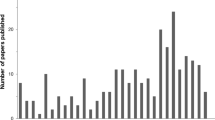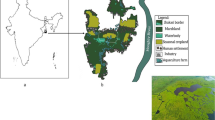Abstract
Wetlands contribute in diverse ways to the livelihoods of millions of people in Sub-Saharan Africa. In many places they are inextricably linked to cropping and livestock management systems. At the same time, increasing population in conjunction with efforts to increase food security is escalating pressure to expand agriculture within wetlands. The environmental impact of wetland agriculture can, however, have profound social and economic repercussions for people dependent on ecosystem services other than those provided directly by agriculture. Currently, the basis for making decisions about the extent to which wetlands can be sustainably used for agriculture is weak. This paper provides an overview of wetland distribution, type and condition across Sub-Saharan Africa. Findings from an investigation of wetland use conducted in Tanzania are presented. These highlight the reliance of communities on both wetland agriculture and natural resources, and show that the nature of household dependence varies significantly from place to place and as socio-economic status changes. Consequently, incentives to manage wetland resources will differ markedly, not only from one location to another, but also across socio-economic groups within the same community. This complexity highlights the need for critical analysis of the social and economic factors that underpin the dynamics of wetland resource use in the development of sustainable management plans.




Similar content being viewed by others
References
Adekola O, Morardet S, de Groot R, Grelot F (2008) The economic and livelihoo value of provisioning services of the Ga-Mampa wetland, South Africa. Proceedings of the 13th IWRA World Water Congress, Montpellier, France, 1–4 September 2008
Bikangaga S, Picchi MP, Focardi S, Rossi C (2007) Perceived benefits of littoral wetlands in Uganda: a focus on the Nabugabo wetlands. Wetlands Ecol Manage 15:529–535. doi:10.1007/s11273-007-9049-3
Bullock A, Gilman K, McCartney M, Waughray D, Blyth K, Andrews A (1998) Hydrological strategy to develop and manage African wetland resources for sustainable agricultural use. Wetland characterisation and classification for sustainable agricultural development. FAO/SAFR, Rome (Part II)
Campbell B (ed) (1996) The miombo in transition: woodlands and welfare in Africa. Centre for International Forestry Research (CIFOR), Bogor, p 266
de Groot RS, Wilson MA, Boumans RMJ (2002) A typology for the classification, description and valuation of ecosystem functions, goods and services. Ecol Econ 41(3):393–408. doi:10.1016/S0921-8009(02)00089-7
Emerton L, Iyango L, Luwum P, Malinga A (1999) The economic value of Nakivubo Urban Wetland, Uganda, Uganda National Wetlands Programme, Kampala and IUCN. The World Conservation Union, Eastern Africa Regional Office, Nairobi
Falkenmark M, Finlayson CM, Gordon L (2007) Agriculture, water, and ecosystems: avoiding the costs of going too far. In: Molden D (ed) Water for food, water for life: a comprehensive assessment of water management in agriculture. Earthscan, London, pp 234–277 (Coordinating lead authors)
FAO (Food, Agricultural Organization of the United Nations) (2001) SEAGA field handbook. Socio Economic and Gender Analysis (SEAGA) Programme, Rome
Finlayson CM (2007) Managing wetland ecosystems–balancing the water needs of ecosystems with those for people and agriculture. In: King C, Ramkissoon J, Clusener-Godt M, Adeel Z (eds) Water and ecosystems: managing water in diverse ecosystems to ensure human well-being. UNU-INWEH, Hamilton, pp 24–38
Finlayson CM, Davidson NC, Spiers AG, Stevenson NJ (1999) Global wetland inventory–current status and future priorities. Mar Freshw Res 50(8):717–727. doi:10.1071/MF99098
IFAD (International Fund for Agricultural Development) (2001) Rural poverty report 2001. The challenge of ending rural poverty. Oxford University Press, Oxford
Jepson P, Whittaker RJ (2002) Ecoregions in context: a critique with special reference to Indonesia. Conserv Biol 16:42–57. doi:10.1046/j.1523-1739.2002.01143.x
Kangalawe RYM (2001) Changing land-use patterns in the Irangi Hills, central Tanzania. A study of soil degradation and adaptive farming strategies. PhD dissertation No. 22, Department of Physical Geography and Quaternary Geology, Stockholm University
Kikula IS (1997) Policy implications on environment: the case of villagisation in Tanzania. The Nordic Africa Institute, Uppsala
Lehner B, Döll P (2004) Development and validation of a global database of lakes, reservoirs and wetlands. J Hydrol (Amst) 296(1–4):1–22. doi:10.1016/j.jhydrol.2004.03.028
Liwenga ET (2003) Food insecurity and coping strategies in semiarid areas: the case of Mvumi in Central Tanzania. Phd Thesis, Department of Human Geography, Stockholm University, pp 186
Masiyandima M, McCartney MP, van Koppen B (2004) Wetland contributions to livelihoods in Zambia. Food and Agricultural Organization of the United Nations, Rome
McCartney MP, van Koppen B (2004) Wetland contributions to livelihoods in Tanzania. Food and Agricultural Organization of the United Nations, Rome
MEA (Millennium Ecosystem Assessment) (2005) Ecosystems and human well-being: health synthesis. World Resources Institute, Washington, DC
Mulugeta S, Abbot P, Hailu A, Sishaw T (2000) Socio-economic determinants of wetland use in the Metu and Yayu-Hurumu Weredas of Illubabor. Report of the Ethiopian Wetlands Research Programme: Sustainable wetland management in Illubabor Zone, South-west Ethiopia, p 36
Omernik JM, Bailey RG (1997) Distinguishing between watersheds and ecoregions. J Am Water Resour Assoc 33:935–949
Pretty J (1995) Participatory learning for sustainable agriculture. World Dev 23(8):1247–1263. Great Britain: Elsevier Science Ltd. doi:10.1016/0305-750X(95)00046-F
Rebelo L-M, Finlayson M, Nagabhatla N (2009) Remote sensing and GIS for wetland inventory, mapping and change analysis. J Environ Manag 90(7):2234–2242
Roggeri H (1995) Tropical freshwater wetlands: a guide to current knowledge and sustainable management. Kluwer Academic Publishers, Dordecht, p 341
Schuyt K (2005) Economic consequences of wetland degradation for local populations in Africa. Ecol Econ 53:177–190. doi:10.1016/j.ecolecon.2004.08.003
Scoones I (1991) Wetlands in drylands: key resources for agricultural and pastoral production in Africa. Ambio 20:366–371
Seyam IM, Hoekstra AY, Ngabirano GS, Savenije HHG (2001) The value of freshwater wetlands in the Zambezi basin. Value of water research report series no. 7. IHE Delft, The Netherlands
Spalding MD, Fox HE, Allen GR, Davidson N, Ferdaña ZA, Finlayson M, Halpern BS, Jorge MA, Lombana A, Lourie SA, Martin KD, McManus E, Molnar J, Recchia CA, Robertson J (2007) Marine ecoregions of the world: a Bioregionalization of coastal and shelf areas. Bioscience 57:573–583. doi:10.1641/B570707
Taylor ARD, Howard GW, Begg GW (1995) Developing wetland inventories in southern Africa: a review. In: Classification and Inventory of the World’s Wetlands, Finlayson CM, van der Valk AG (eds) Advances in vegetation science 16. Kluwer Academic Publishers, Dordrecht, pp 57–79
Terer T, Ndiritu GG, Gichuki NN (2004) Socio-economic values and traditional strategies of managing wetland resources in Lower Tana River, Kenya. Hydrobiologia 527:3–14. doi:10.1023/B:HYDR.0000043332.96368.c5
Turpie JK, Smith B, Emerton L, Barnes J (1999) Economic valuation of the Zambezi basin wetlands. Report to IUCN ROSA, Harare
Wood A, van Halsema GE (2008) Scoping agriculture-wetland interactions: towards a sustainable multiple-response strategy. FAO Water Report 33, Food and Agriculture Organization of the United Nations, Rome, Italy
Acknowledgments
The case studies were collaborative initiative undertaken between FAO, IWMI and IUCN-ROSA. They were funded by the FAO Netherlands Partnership Program. The authors are grateful to the case study partners who conducted a lot of the fieldwork—S. Shaaban, M. Mchenga, A. Mbinga on Zanzibar and R. Kangalawe and E. Liwenga in the Kilombero Valley. The involvement of the communities that participated in these studies and especially those households who gave up their time to complete the questionnaire is gratefully acknowledged.
Author information
Authors and Affiliations
Corresponding author
Rights and permissions
About this article
Cite this article
Rebelo, LM., McCartney, M.P. & Finlayson, C.M. Wetlands of Sub-Saharan Africa: distribution and contribution of agriculture to livelihoods. Wetlands Ecol Manage 18, 557–572 (2010). https://doi.org/10.1007/s11273-009-9142-x
Received:
Accepted:
Published:
Issue Date:
DOI: https://doi.org/10.1007/s11273-009-9142-x




